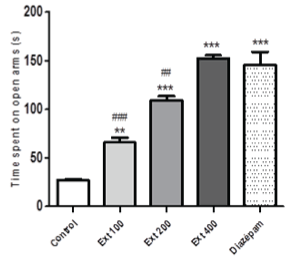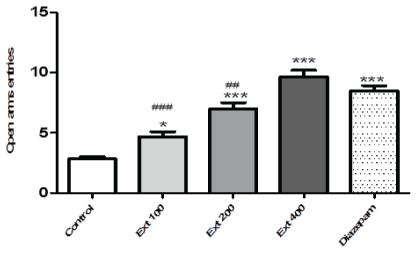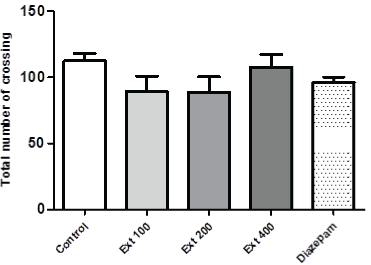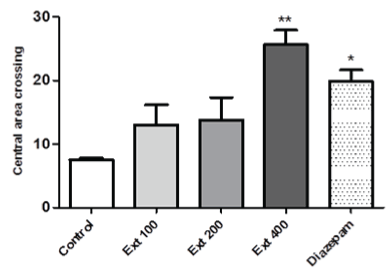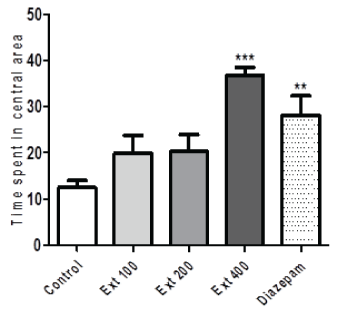Anxiety Behavior is reduced in the Balb/C Mice that Treated by Methanolic Extract of Urtica urens: An Elevated plus Maze and Open Field Analysis
Zouhra Doukkali, Khalid Taghzouti, EL Houcine Bouidida, Rabie Kamal, Mohamed Nadjmouddine, Yahya Cherrah, Katim Alaoui
| Zouhra Doukkali1,*, Khalid Taghzouti2, EL Houcine Bouidida3, Rabie Kamal1, Mohamed Nadjmouddine1, Yahya Cherrah1, Katim Alaoui1 1 Pharmacodynamics Research Team, ERP, Laboratory of Pharmacology and Toxicology, Faculty of Medicine and Pharmacy, University Mohammed V of Rabat, Morocco; 2 Laboratory of Animal Physiology, Department of Biology, Faculty of Science, University Mohammed V of Rabat, Morocco; 3 National Laboratory of Drug Control, Directorate of Pharmacy, Ministry of Health, Rabat, Morocco. |
| Corresponding author. Tel: 9329844585; E-mail: d.zouhra@yahoo.fr |
| Received: December 22, 2015 Accepted: January 11, 2016 Published: January 18, 2016 |
| Citation: Doukkali Z, Taghzouti K, Bouidida EL, et al. Anxiety Behavior is reduced in The Balb/C Mice that Treated by Methanolic Extract of Urtica urens: An Elevated plus Maze and Open Field Analysis. Electronic J Biol, 12:1 |
Abstract
Background The most widely prescribed medications for anxiety disorders are the Benzodiazepines; however, they have prominent side effects. Thus, interest in alternative medicine that affects the ‘mind’ is growing. Among medicinal plants, Urtica urens has been recommended for relief of anxiety in Morocco folk medicine. Nevertheless, no pharmacological studies have thus far evaluated its effects on central nervous system.
Methods This work is aimed to evaluate a possible anxiolyticlike effect of methanolic extract of Urtica urens in the elevated plus maze (EPM) and Open Field (OF) models of anxiety. The Urtica urens extract was administered orally to Balb/c mice, at graded doses and diazepam was given intraperitonealy.
Results In the EPM, methanolic extract at 100-400 mg/kg showed an anxiolytic effect by increasing the time spent on open arms and the percentage of open arm entries compared to control group. In an open field test methanolic extract of U. urens (400 mg/kg) increased the central area crossing, the time spent and number of rearing in the center of arena.
Conclusion These data support that the methanolic extract of Urtica urens might possess significant anxiolytic potential to be pursued further for drug development process and provide a scientific evidence for its traditional claim.
Keywords |
||||||||||||
| Anxiety; Balb/c mice; Elevated plus maze; Open field; Methanolic extract of Urtica urens; Morocco. | ||||||||||||
Abbreviations |
||||||||||||
| U. urens: Urtica urens; Ext 100: Methanolic extract of Urtica urens 100 mg/kg; MeOH extract: Methanolic extract. | ||||||||||||
1. Introduction |
||||||||||||
| Anxiety disorders are the most frequent mental disorders, affecting 7-14% of the general population at any given time point [1-3], these disorders have a much earlier age of onset than other chronic conditions [4]. | ||||||||||||
| As in example, in Morocco, anxiety disorders affect 9% of the population according to the national survey on mental health conducted by the Ministry of Health [5]. Pivotal element of anxiety disorders is a long-lasting feeling of distress and/or apprehension for no evident reason [6]. Anxiety disorders exact a pervasive toll on the individual and impair numerous aspects of quality of life by inducing physical, social, emotional, and occupational dysfunction [7]. This class of disorders, which includes Agoraphobia, Specific Phobia, Social Anxiety Disorder (Social Phobia), Panic Attack, Separation Anxiety Disorder, and Selective Mutism [8] became a very important area of research interest in psychopharmacology. It is well known that changes and control of emotion are related to dysregulation and neurochemical abnormalities in a certain specific pathway or neurotransmitter that is theoretically implicated in anxiety. | ||||||||||||
| Since the introduction of benzodiazepine in the 1960s, they have been the most commonly employed medicinal treatment for anxiety [9,10], and are relatively safe drugs for a short-term treatment of anxiety despite their drug dependence potential and side effects [11,12]. | ||||||||||||
| Current drug therapies for anxiety have many limitations, including the high financial expense (anxiety disorders incur substantial cost to both the individual and society), delay in onset, limited efficacy, unwanted side effects, dependence, and stigma associated with consuming and depending on pharmaceuticals [13,14]. | ||||||||||||
| Thus, a need to develop novel treatments to fulfill these shortcomings exists, and the study of medicinal plants could provide new therapeutic options [15]. | ||||||||||||
| Our previous studies also involved evaluation of Urtica urens [16] for their anxiolytic effects in 3 paradigms models of anxiety light/dark test, Hole board and Rotarod. In this study, we extended our search for the same plant to confirm his anxiolytic effect by another models of anxiety. | ||||||||||||
| In Morocco, four species of Urtica which belongs to the Urticaceae family are available [17]. Urtica urens commonly known as an herbaceous annual plant species of the genus Urtica, and has long been known to have tranquillizing effects among the Moroccan people. Despite the wide spread use of U. urens as an anxiolytic, there are no pharmacological data to support such effect, except our paper [16] therefore we undertook, the study to confirm the anxiolytic potential the methanolic extract of U. urens by using different animal models and several anxiety paradigms. | ||||||||||||
| Despite the widely popular use of this plant in Morocco, there is no available scientific information about the potential effects of Urtica urens animal models of psychiatric disorders especially in anxiety. Therefore, the present study was conducted to confirm our observation [16] concerning the anxiolytic effect of Urtica urens by 2 excellent models of anxiety EPM and OF. | ||||||||||||
2. Materials and Methods |
||||||||||||
2.1. Animals |
||||||||||||
| Balb/c mice of either sex (20-30 g) were employed in the present study. Animals were procured from the animal experimental center of Mohammed V. University, Medicine and Pharmacy Faculty, Rabat. | ||||||||||||
| Animals were provided normal diet and water ad libitum and were maintained in a room with controlled temperature of 20-25°C, and lighting (light/dark 12:12 hour) in polypropylene cages. The animals were acclimatized to the laboratory condition before experiments at least 1 h. The Open field and the elevated plus maze were performed between 2 p.m and 6 p.m. | ||||||||||||
2.2 Plant material |
||||||||||||
| The aerial part of Urtica urens was collected from the north of Morocco near the town of Wazzan (Jaaouna el Basra), with assistance of a traditional medical practitioner. The plant was authenticated by botanists of scientific institute Pr. M. Ibn Tatou and Pr. Halim Khammar. A voucher specimen (N° RAB78983) was deposited in the Herbarium of Botany Department of the Scientific Institute of Rabat. | ||||||||||||
2.3 Preparation of the methanolic extract |
||||||||||||
| The aerial part was dried at room temperature and crushed. 700 g of plant material was extracted with six liter of methanol by maceration at room temperature (25°C) over period of 48 hours. Methanol containing the extract was then filtered through Whatman paper and the solvent was vacuum-distilled at 60°C in a rotary evaporator. The remaining extract was finally dried by desiccator. Final extract was a dark green paste, with 11.92% dry weight. The residue was dissolved in water for final suitable concentrations. | ||||||||||||
2.4 Drugs and chemicals |
||||||||||||
| The methanolic extract of Urtica urens was suspended in distilled water. Diazepam 10 mg/2 ml was diluted with saline to the required concentration before use. It is well known that benzodiazepines act as anxiolytics at low doses and that they induce sedation and muscle relaxant effects at higher doses [18]. Therefore, we used diazepam (1 mg/kg; ip) as a positive control for anxiolytic-like effects. | ||||||||||||
2.5 Treatment schedule |
||||||||||||
| Animals were divided into four groups, each consisting of six mice. Experimental groups of mice were treated orally (p.o.) with methanolic extract of Urtica urens at doses of (100, 200 and 400 mg/kg), whereas control groups received vehicle-treated group by the same routes, the trial was carried out 1 H after the treatments. Diazepam (1 mg/kg) was administered intraperitoneally (i.p.) the trial was carried out 30 min after the treatments. All drugs were freshly prepared before each experiment. The doses of extracts were calculated to administer 0.25 ml of the suspension of extracts to the mice of 20 mg. The anxiolytic activity was examined by using the EPM and OF test. | ||||||||||||
2.6 Behavioral paradigms |
||||||||||||
| Elevated plus maze. The elevated plus maze (EPM) was first proposed as an animal model of anxiety by Handley and Mithani [19] Constructed of black colored wooden planks consisting of two close arms, 50 cm × 10 cm × 40 cm, and two open arm, 50 cm × 10 cm, connected to a central platform (10 cm × 10 cm). Covered with a removable lid, such that the open or closed arms were opposite to each other [20].The maze was elevated to a height of 50 cm above the floor. During the experiment each mouse was placed in the central compartment facing one of the open arms. The number of entries and the time spent in open arms were recorded for 5 min. An entry was counted when all four paws of the mouse entered an open or closed arm. An increase in open arms entries and increase in time spent in open arms were interpreted as an index of potential anxiolytic activity. All test sessions were taped by using a video camera. | ||||||||||||
| Open field test. Experimental groups of 6 mice were treated with vehicle saline, methanolic extract of Urtica urens (100, 200, 400 mg/kg, po) or diazepam 1 mg/kg, ip). After the treatement -Sixty minutes for methanolic extract and 30 min for Diazepam- the animals were placed individually in the center of the arena and were subjected to a 5-min period to the open field test. The open field apparatus was an opaque plexiglass cage (72 × 72 cm) with walls 35-cm in height where the floor was divided with white lines by 16 squares (18 × 18 cm) of identical dimension. A digital video camera was installed above the cage to record the activity of the mice. The entire room, except the OF was kept dark during the experiment, in this study was evaluated both the general motor activity of the mice to discard hypoactivity, hyperactivity, or no changes associated with treatments, which could interfere with the behavioral activity of the mice in the elevated plus maze also the observed parameters were as follows: (a) total number of crossings, (b) central area crossings, (c) time spent in central area, (d) central area rearing [21,22]. | ||||||||||||
| After each test session, the elevated plus-maze apparatus and the open field cage were carefully cleaned with water and allowed to dry to remove the scent of the previously evaluated animal, which could otherwise modify the spontaneous behavior of the subsequent evaluated mice [23]. | ||||||||||||
| Also this test reflects the conflict between the innate fear that mice have of the central area of a novel open field versus their desire to explore new environments. When anxious, the natural tendency of mice is to prefer staying close to the walls. | ||||||||||||
2.7 Statistical analysis |
||||||||||||
| All the results were expressed as mean ± SEM. All statistical analysis was done using one way analysis of variance (ANOVA) followed by the Turkey’s post hoc test. P<0.05 was considered as significant when compared to their respective control group. | ||||||||||||
3. Results |
||||||||||||
3.1 Elevated plus maze |
||||||||||||
| ANOVA of the times spent by mice in the open arms of elevated plus maze test showing significant (P?0.05) differences between the groups (Figure 1). | ||||||||||||
| All values are mean ± SEM (n=6); *p<0.05, ***p<0.001 when compared to control. One- way ANOVA, Tukey's Multiple Comparison post hoc tests. ##p<0.01, ###p<0.001 when compared Ext 100 and Ext 200 to Ext 400. | ||||||||||||
| Post hoc comparisons made with Tukey’s test revealed animals which received MeOH extract of Urtica urens (100-400 mg/kg, po.) and intraperitoneal diazepam 1 mg/kg increased the time spent on the open arms compared to the control group (P?0.01 and P?0.001, respectively). | ||||||||||||
| The values of the group treated with Urtica urens at 400 mg/kg body weight were higher than that of the treatment with lower doses (100,200 mg/kg). | ||||||||||||
| Similarly, ANOVA of the number of entries into open arms of the elevated plus maze showing significant (P?0.05) differences between the groups. Further post hoc comparisons made with Tukey test revealed that animals receiving MeOH-extract of Urtica urens (100-400 mg/kg) made significantly more entries into open arms of the maze than control (P?0.05 and P?0.001, respectively) Figure 2. | ||||||||||||
| All values are mean ± SEM (n=6); *p<0.05, ***p<0.001 when compared to control. One- way ANOVA, Tukey's Multiple Comparison post hoc tests. ##p<0.01, ###p<0.001 when compared Ext 100 and Ext 200 to Ext 400. | ||||||||||||
| However, 400 mg/kg body weight treated groups showed higher number of entries and more time spent in open arms comparable to that of standard drug diazepam 1 mg/kg. | ||||||||||||
3.2 Open field |
||||||||||||
| Total crossing. In the open field test, no difference was observed in locomotor activity (Total number of crossing) between groups (Figure 3). | ||||||||||||
| All values are mean ± SEM (n=6). One-Way ANOVA, Tukey's Multiple Comparison post hoc tests. | ||||||||||||
| Central area crossing. All values are mean ± SEM (n=6); *p<0.05, **p<0.01 when compared to control. One- way ANOVA, "Tukey's Multiple Comparison post hoc tests. | ||||||||||||
| The post-hoc test revealed that central area crossing was only augmented in 400 mg/kg of Urtica urens and diazepam respectively (P?0.001, P?0.05, respectively) as compared with the control and remaining groups Figure 4. | ||||||||||||
| Time spent in central area. Mice treated with either 400 mg/kg or diazepam spent significantly more time in the central area (P?0.01, P?0.001, respectively) Figure 5. | ||||||||||||
| All values are mean ± SEM (n=6); **p<0.01, ***p<0.001 when compared to control. One- way ANOVA, "Tukey's Multiple Comparison post hoc tests. | ||||||||||||
| Central area rearing. Central area rearing was increased by MeOH extract of Urtica urens 400mg/ kg and diazepam 1 mg/kg (P?0.001, P?0.05, respectively) Figure 6. | ||||||||||||
| All values are mean ± SEM (n=6); *p<0.05, ***p<0.001 when compared to control. One- way ANOVA, "Tukey's Multiple Comparison post hoc tests. | ||||||||||||
4. Discussion |
||||||||||||
| In the current work, we examined the anxiolytic properties of Urtica urens. We have chosen to evaluate the methanolic extract of Urtica urens treatment behavioral anxiolytic effect in tow of the most validated models for researching anxiety like behavior in animals, namely the Elevated plus maze and the Open field are a well-accepted, experimental animal model typically used to test the effectiveness of anxiolytics drugs [24-26]. The methanolic extract of Urtica urens Showed promising anxiolytic effects without causing any neuromuscular side effect [16]. | ||||||||||||
| The elevated plus maze test is based on the observation that the natural behavior of rats or mice to display an aversion to novel open spaces and fear of balancing on a relatively narrow, raised platform that can induce anxiety in humans [26]; therefore, avoidance of the open arms is interpreted as anxiogenic behavior [25-28]. An anxiolytic agent increases the exploration of the open arms (time and entries into open arms). Diazepam increases the percentage of open arms entries and the time spent in the open arms [28], confirming its anxiolytic effects. Finding of this study show that animals treated with graded doses of Urtica urens (100-400 mg/kg) increased the entries into and time spent in the open arms, indicating an anxiolytic like effect, in addition to the fact that this reduction an anxiety like behavior was similar to the one observed following the conventional treatment with the diazepam. | ||||||||||||
| The open field is a very popular animal model of anxiety-like behavior. Since the creation of the open field test, conceived in 1934 to provide objective measures of emotionality in rats [29], the procedure consists of subjecting an animal, usually a rodent, to an unknown environment from which escape is prevented by surrounding walls [30]. | ||||||||||||
| In fact, anxiety behavior in the open field is triggered by two factors: individual testing (the animal is separated from its social group) and agoraphobia (as the arena is very large relative to the animal’s breeding or natural environment). | ||||||||||||
| The open field test is designed to study exploratory activity [31]; in this test, Urtica urens did not alter the crossing number (Figure 3), which supports the lack of alteration in motor coordination previously observed in the rotarod test [16]. Methanolic extract of U. urens treatment with 400 mg/kg body weight increased the preference for the central area enhancing the crossing number, the time spent and the rearing in the central area of the apparatus (Figures 4-6); an increase in these parameters could be indicative of anxiolytic-like effects [32]. | ||||||||||||
| The efficacy of most herbal remedies is attributed to various active principles in combination, in the present study methanolic extract from areal part of U. urens containing significant amounts of flavonoid composants [33,34] which are probably more responsible for the anxiolytic activity of U. urens. Recently some natural and synthetic flavonoids have been found to bind specifically and competitively to benzodiazepine receptors and to possess anxiolytic effects [35-37]. | ||||||||||||
5. Conclusion |
||||||||||||
| In conclusion, the data presented hereby reinforce the traditional use of U. urens [16] and indicate that the methanolic extract of the aerial parts of Urtica urens L. has anxiolytic-like effects. Thus, Urtica urens may be a promising candidate for future development as a new anxiolytic drug. Further pharmacological investigations are underway to identify the active constituents of the plant extract responsible for the showed activity. Knowing the precise mechanism of how these extracts function and at what molecular targets they act should give us insights into how to develop better mood aids based on the natural products. | ||||||||||||
5.1 Conflict of interest statement |
||||||||||||
| All authors assert that none has any commercial or financial involvements that might present an appearance of a conflict of interest in connection with the submitted manuscript. | ||||||||||||
6. Author’s Contribution |
||||||||||||
| DZ, I carried out all the studies and drafted the manuscript with the help of the above authors, as regards TK participated in this work and drafted with me the manuscript. EHB helped us in the chemistry part and NM carried out the behavioral tests with me, and CY is the director of the laboratory he advises me and guides me always in my work, after my PhD supervisor KA she corrects the manuscript, guides me and advises me. All authors read and approved the final manuscript. | ||||||||||||
7. Author Details |
||||||||||||
| Pharmacodynamy Research Team, ERP, Laboratory of Pharmacology and Toxicology, Faculty of Medicine and Pharmacy, University Mohammed V of Rabat Morocco. | ||||||||||||
Acknowledgement |
||||||||||||
| We are grateful to Pr. Zellou Amina, PES in faculty of medicine and pharmacy, Rabat. Thanks are due to Pr. Halim Khammar, and Pr. Fennane, botanists of scientific institute for their participation on this work, we would also like to thank the students PhD: Meriem Jemly, Rabie Kamal, Hanae Hosni, Amina Bounihi for their encouragement and interest in the research work. | ||||||||||||
Figures at a glance |
||||||||||||
|
||||||||||||
References |
||||||||||||
|

Open Access Journals
- Aquaculture & Veterinary Science
- Chemistry & Chemical Sciences
- Clinical Sciences
- Engineering
- General Science
- Genetics & Molecular Biology
- Health Care & Nursing
- Immunology & Microbiology
- Materials Science
- Mathematics & Physics
- Medical Sciences
- Neurology & Psychiatry
- Oncology & Cancer Science
- Pharmaceutical Sciences
